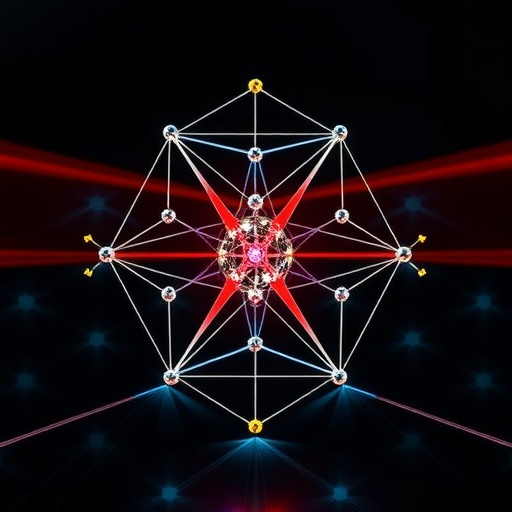In a groundbreaking advancement at the nexus of photonics and materials science, researchers have unveiled a novel class of asymmetric topological photonic states within anisotropic two-dimensional (2D) perovskite microcavities. This revelation marks a pivotal milestone in the exploration of light-matter interactions in low-dimensional systems, promising transformative implications for next-generation photonic technologies.
Topological photonics, an emergent field inspired by the robust principles of topology in condensed matter physics, has profoundly reshaped the manipulation and control of light. Traditionally, these topological states have been realized in isotropic media, where uniform physical properties govern photon propagation. However, the intrinsic anisotropy present in certain 2D perovskite materials introduces unprecedented complexity and richness to the photonic band structure, unlocking asymmetric states that challenge existing paradigms.
At the heart of this research lies the sophisticated engineering of microcavities composed of layered 2D perovskite crystals, a class of materials celebrated for their remarkable optoelectronic properties, tunable bandgaps, and facile fabrication techniques. By harnessing the anisotropic dielectric environment within these microcavities, the team was able to experimentally and theoretically demonstrate asymmetric photonic modes exhibiting topological protection—an attribute that ensures their resilience against defects and disorders traditionally detrimental to optical systems.
Critically, these asymmetric topological states manifest unique directionalities and polarization characteristics, deviating from conventional symmetric counterparts. This anisotropy-induced asymmetry empowers unidirectional light flow and robust mode confinement, heralding new horizons for nonreciprocal photonic devices such as isolators and circulators that are integral to optical communication networks.
The theoretical framework underpinning these observations was meticulously constructed using advanced computational models incorporating anisotropic permittivity tensors and spin-orbit coupling analogs inherent to the perovskite lattice structure. By simulating the interplay between photonic crystal symmetries and the structural anisotropy, the researchers identified topological invariants rooted in the system’s band topology, thereby predicting the emergence of protected states localized at the microcavity interfaces.
Experimentally, the group employed angle-resolved photoluminescence and near-field scanning optical microscopy to probe the microcavities’ photonic dispersion relations and spatial mode profiles. The data unveiled clear signatures of asymmetric edge modes that defy backscattering, consistent with the theoretical predictions. Notably, these phenomena persisted even amidst structural imperfections, underscoring the topological robustness of the discovered states.
From a materials perspective, the choice of 2D perovskites plays a crucial role. The layer-dependent anisotropy intrinsic to these crystals arises from their unique organic-inorganic hybrid composition, leading to directionally dependent refractive indices and excitonic resonances. This anisotropy not only tailors the photonic band structure but also amplifies spin-dependent light-matter interactions, essential for the manifestation of complex topological phases.
The implications of these findings are vast. Integrating asymmetric topological photonic states into practical devices could drastically enhance the efficiency and stability of on-chip optical circuits. For instance, the inherent robustness to defects could mitigate scattering losses in nanoscale waveguides, enabling ultra-compact, low-power photonic components. Furthermore, the directional control of light could stimulate innovations in quantum photonic networks where coherent information transfer and fault tolerance are paramount.
Another compelling aspect lies in the tunability offered by 2D perovskite materials. Through chemical composition adjustments and external stimuli such as strain or electric fields, the anisotropy and, consequently, the topological characteristics can be dynamically modulated. This dynamic control paves the way for reconfigurable photonic elements, adaptable to variable operational demands or environmental conditions in real-time.
Moreover, the research opens intriguing possibilities for exploring non-Hermitian and nonlinear topological photonics within anisotropic platforms. Given that perovskites exhibit significant nonlinear optical responses, future studies could delve into the interplay between topological protection and nonlinear phenomena, potentially leading to novel photon-based logic components or all-optical signal processing.
Importantly, this advancement bridges a critical gap in the field by extending topological photonics beyond the realm of symmetric systems, offering a more comprehensive understanding of how crystalline anisotropy influences photonic topology. Such insights deepen the fundamental comprehension of topological phases and broaden the toolkit available for engineering complex photonic band structures with customized functionalities.
Collaborations spanning experimentalists, theorists, and materials scientists were key to this multifaceted achievement. The synergy enabled accurate design, fabrication, and characterization of the anisotropic 2D perovskite microcavities, ensuring the theoretical predictions were faithfully realized and observed in practice.
In the broader context of sustainable technology and telecommunications, the capacity to manipulate light with high precision and minimal loss is critical. As global data consumption escalates, innovations that facilitate faster, more reliable, and energy-efficient optical devices are indispensable. Asymmetric topological photonic states in anisotropic materials like 2D perovskites represent a promising avenue toward meeting these technological imperatives.
Looking ahead, the research community anticipates leveraging these insights to develop integrated photonic chips where asymmetric topological states are harnessed for sophisticated functionalities including topological lasers, sensors, and quantum computing architectures. The intersection of anisotropy and topology promises a fertile ground for discoveries, transcending conventional limitations and reshaping the future landscape of photonics.
Ultimately, this seminal work not only expands the theoretical and experimental frontiers of topological photonics but also sets a new course for the design of advanced photonic materials and devices. As asymmetric topological states in anisotropic 2D perovskite microcavities become better understood and controlled, their deployment in real-world applications appears imminent, heralding a new chapter in the evolution of light-based technologies.
Subject of Research: Asymmetric topological photonic states in anisotropic 2D perovskite microcavities
Article Title: Unveiling asymmetric topological photonic states in anisotropic 2D perovskite microcavities
Article References: Mavrotsoupakis, E.G., Mouchliadis, L., Cao, J. et al. Unveiling asymmetric topological photonic states in anisotropic 2D perovskite microcavities. Light Sci Appl 14, 207 (2025). https://doi.org/10.1038/s41377-025-01852-8
Image Credits: AI Generated




